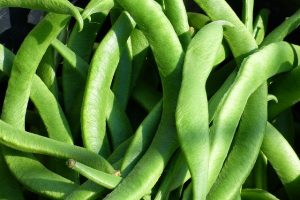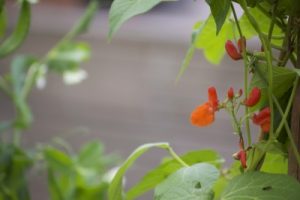I cannot imagine a summer growing season where I have not grown runner beans and enjoyed them as a delicious offering with goats cheese in a pasta sauce or that infamous harbinger of taste, the Keralan Runner Bean curry. It is one of the easiest vegetables to grow and if conditions are right produces an overabundance of pods which I’m soon donating to friends less fortunate with garden space. It really is a gift that keeps on giving because the beans have to be picked continuously and they keep on coming. However, they are not everyone’s favourite but that seems at odds with the considerable popularity we have seen with them over the years.

They also demand little space and can even be grown in patio pots against a wall – yes, they are that versatile ! When they were first grown, the Georgians and Victorians in particular enjoyed them for their bright scarlet blooms but soon the pods were being eaten as an immediate cash crop. Those heart shaped blooms are also ideal for attracting bees to the vegetable plot which is no mean feat as they may be the only flower worth growing in that patch.
Where should I grow my Runner Beans
Runner Beans grow best in a sunny or semi-shaded spot with shelter from strong winds. They are at their best in fertile, well drained soil but even poor soils can deliver a reasonable crop. Prepare the site for the beans in spring by digging it over and adding some well rotted organic matter such as grass compost, but avoid adding manure immediately before planting as this encourages more foliage than beans to form.
Sowing runner beans from seed
Sowing indoors:
From late March to April, I start Runner Bean seed off in small pots (2.5in or 7cm) and tray modules for transplanting later on in my prepared ground. Simply fill a pot with seed compost and make a hole of about 5cm (2″) deep. Drop in a Runner Bean seed and then fill the hole with compost. Water making sure the compost is wet but not sodden as rotting can occur.
Runner beans germinate in seven days and grow surprisingly extremely rapidly which has caught some gardeners off-guard. Harden the plants off for 7 to 12 days before transplanting them outdoors. Check they are fully rooted in to their pots before planting in their allotted part of the garden, and keep a close eye on the weather to ensure that all risk of frost has passed. That will be from around the end of May in England and mid-June in the higher reaches of Scotland.

Direct sowing outdoors:
The alternative is to sow Runner Bean seed directly into the ground from May to July where they are allowed to run up their cane structures. I do this where I perceive gaps. I sow them at a depth of 5cm (2″) and a distance of 30cm (12″) apart in adjacent rows that are then set about 45cm (18″) apart.
Where space is limited, Runner Beans can be allowed to wind up a wigwam cane or willow structure as they perform like sweet peas in offering a feast of colour. They are perfectly happy growing in containers too, so it’s possible to have a tasty crop direct from the patio.
For the longest cropping period, sow indoors and outdoors to produce early and main season crops. It is also possible to sow seeds outside up until the end of July for a much later autumn crop. It’s also sensible to sow a few extra seeds at the end of each row, as spare plants for filling gaps in the rows where seeds have failed to germinate. If these plants aren’t needed then I pass them on to others or I plant in the flower border just for effect. I’ve received a few interesting varieties too in the process.
Plant supports for Runner Beans
Runner Beans require support from garden canes, strings or netting. Ideally these should be in place at the time of planting, but they can be added after shoots have formed if necessary.
The most commonly used runner bean support is an A-frame of garden bamboo or ash canes which spans two adjacent rows of runner beans. Insert a tall garden cane next to each seedling and then tie each cane to the one opposite with garden twine to create a tunnel. A supporting cane run along the top of the framework will help to hold the structure rigid. The beans will naturally twine their stems around the canes as they grow. If we have more advice on creating artistic supports below.
Bamboo Canes Or Coppiced Hazel Poles ?
When growing Runner Beans in containers, a wigwam framework is preferable. This can be created from a circle of garden canes, tied together at the top. The alternative is the criss-cross framework.
The coppiced hazel poles always look good. They allow for some creativity, are tall and sturdy with a beautiful rustic feel in their appearance. I believe they always add plenty of character to the vegetable plot.
Hazel poles are usually prepared as a wigwam or a lattice screen. Whatever runner bean you grow against them, never fear, they will always wind their way around the pole although at the beginning they might need a guiding hand.
We have tried shaped metal frames but these are not cheap although they do lend some sophistication to the vegetable patch or allotment. We’ve also tried a wooden trellis especially against a garden wall or fence and plastic horticultural mesh will do a grand job. The wooden trellis when nailed to some sturdy posts offers the gardener with a keen artistic eye, the opportunity to personally wind a runner bean around.
Willow stems look great! Cut some willow stems to the ground, strip away the leaves and place firmly in the ground. You tie the stems together into various creative shapes which allows those beans to wander freely through the supports.
Dogwood is worth considering too. If you have been spring pruning the red and yellow stems of Cornus then you have a beautiful set of coloured stems for tying up. These very flexible stems make superb trellis like structures and woven screens. Train the runners at an angle through the lower sections and then allow to wander freely too.
The most adventurous might try old trees. Apple, plum and pear trees make excellent supports – especially the really old ones before they have to be cut down.
Caring for the Runner Beans
Throughout the growing season you will need to water your beans regularly, particularly as they start to develop flowers. Dryness is one of the main reasons why runner bean flowers can fail to set pods. A liquid feed applied every 14 days will also help to maximise your crop.
Pinch out the growing tips of the plants once the stems reach the tops of their canes to divert their energy onto producing beans rather than growing tall.
Harvesting Runner Beans
Runner Beans can be harvested from July when the pods reach 20cm (8″) long. Pick beans every 2 or 3 days to ensure that they are tender and prevent them becoming stringy. The more you pick, the more pods will be produced! Don’t worry if you end up with a glut as they can easily be frozen and enjoyed later in the year but it is a good idea to blanch the pods before freezing just to reduce over-softening.
What Prevents Pods From Setting
Runner beans are a cool-season crop so they grow particularly well in the UK. Most people will not experience many serious problems with this crop at all. Nonetheless, gardeners do sometimes find that their crop may fail to set pods, particularly early on in the season.
Acid soils and very poor soils reduce crop production so it is well worth taking the time to prepare the soil properly before planting Runner Beans.
When night temperatures are particularly high, this can affect the production of pollen and often there is a reduction in the number of pods setting. As temperatures begin to cool, this problem will resolve itself and normal production of pollen and beans should resume.
Poor setting occurs if temperatures are too high and the roots are dry during the period when the flowers and the pods appear. Regular watering and mulching with organic matter will help reduce this issue. Ensure watering is conducted regularly – I prefer a drip style just to keep the soil moist.
In very cold and wet summers there is sometimes a lack of pollinating insects. This usually improves with a change in weather conditions. I grow sunflowers and other flowering plants just to attract pollinators especially bees to the patch.
Birds are a nuisance when they peck the flowers and damage them. These can be easily discouraged by hanging bird scarers close by such as a plastic hawk kite, old cd’s or pieces of tin foil. A living cat stalking the vegetable patch also helps.
Finally, it is essential that the pods are picked regularly even if you have too many and your freezer is bursting! Infrequent picking slows the production of any new pods as the plants focus their energies on producing seed instead.
Varieties Of Runner Beans.
Click on the name to be taken to our affiliate marketing site (SimplySeeds) where you can purchase the following varieties.
cv. Tenderstar. A variety, 15 years in the breeding. It’s a cross between a runner bean and a French bean which gives it great flavour and perhaps more importantly great texture. The flowers are also ornamental coming in a red and white combination in great profusion.
cv. Equator. A super white flowered variety. It is worth the extra cost because it is semi-self pollinating and relatively drought resistant. Will produce a good crop in dry summers when other runner beans just fail. The plants have good vigour and produce high yields of bean approx. 25cm in length, and show good virus resistance to plant diseases.
cv. Enorma. One of the most popular and a prizewinner. Produces straight, long pods, at 30-32cm in length. It has red flowers with purple seed and a wonderful flavour. Generally one for the allotment. harvest from July onwards.
cv. White Lady. A modern white flowered variety with superb flavour. Produces medium- green pods which are smooth, slender and fleshy. They typically reach up to 30cm in length. They are good pod setters even in hot weather. Relatively stringless.
Please note we are an affiliate marketing partner. Please read our affiliate disclosure.
Leave a Reply